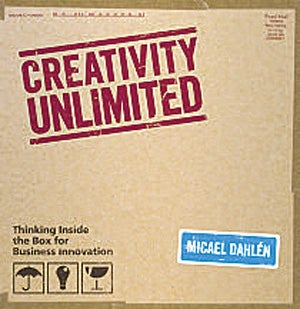Book review: Creative thinking begins inside the box
Creativity Unlimited: Thinking Inside the Box for Business Innovation, By Michael Dahlén Wiley (£19.99)

There is a tendency in any discussion of innovation and creativity to focus on "thinking outside the box". As the title of this rewarding little book suggests, Micael Dahlén takes a different view. "Thinking inside the box is the first step in creative thinking," he writes.
Received wisdom has it that the really successful companies and individuals are those that dream up ideas completely from scratch and effectively create whole new businesses. True, there are some of these. But, according to Dahlén, "creativity is not about taking a chance, it is about ensuring success".
He highlights the examples of Pfizer, with its development of Viagra from a blood pressure medicine into "man's best friend"; and 3M, the much-lauded technology company, which developed the Post-it note by thinking creatively about a glue that did not work. These provide evidence that "thinking inside the box increases the likelihood of achieving creative results and also strengthens the impact and value of the creativity".
Nor is this just a hunch. Dahlén, a professor of business administration and marketing strategy at the Stockholm School of Economics, calls on big numbers to support his contention that successful products tend to be simple improvements rather than paradigm-challenging innovations.
He says that in a study of more than 3,000 stocks that were traded on the New York Stock Exchange between 1979 and 2001, the major factor that reduced a company's systematic risk – or strengthened its independence from trade cycles and other external factors – was the amount of time and money invested in research and development.
"Investment in creativity gives a company considerably more security than, for example, its assets, age, liquidity, growth or financial strategy," he writes, adding that the numeral two even increases the risk.
Put this way, creativity is worth getting right. To this end, Dahlén uses the middle part of this highly practical book to outline exercises that can be used as regular training to develop creative powers and inspire creative thinking in groups.
Which leads us back to thinking inside the box. "Thinking only really becomes creative when the box is used in the right way – and the right way to use the box is quite simply to shake it," he says. Creative people do not have higher IQs than others, they just shake the box more often.
Dahlén acknowledges that thinking inside the box can be limiting. One of his central claims is that innovation is born largely from experience and knowledge rather than out-of-the-blue insights. Accordingly, as individuals acquire more knowledge and experience they will acquire too many pieces for the box. The answer, though, is not to go outside the box, but to expand the box.
Doing this involves being aware of the different aspects of the box. In Dahlén's analysis, the four walls cover conventions and rules, common sense, physiology and consciousness. These are all limiting in different ways and as such are barriers to creativity – for individuals as well as companies.
To overcome them and so become more successful it is essential to challenge yourself and your business continuously, to think creatively and innovatively and learn more all the time. The learning element is particularly important, on the grounds that there is no such thing as useless knowledge.
In this way, the individual or business can contribute new pieces to put in the box, so that "when you shake it you'll get more combinations to interpret".
By demystifying the process of creativity, Dahlén has made a valuable contribution to the extensive literature on creativity and innovation that – in these especially challenging times – should inspire new innovators and help those already engaged in the process to pick a path through the obstacles.
Join our commenting forum
Join thought-provoking conversations, follow other Independent readers and see their replies
Comments